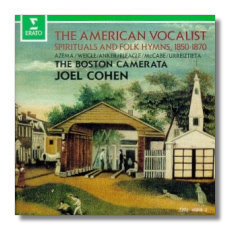
The Internet's Premier Classical Music Source
Related Links
- Latest Reviews
- More Reviews
-
By Composer
-
Collections
DVD & Blu-ray
Books
Concert Reviews
Articles/Interviews
Software
Audio
Search Amazon
Recommended Links
Site News
 CD Review
CD Review
The American Vocalist

Spirituals and Folk Hymns, 1850-1870
- Works from The American Vocalist and The Revivalist
The Schola Cantorum of Boston
The Chamber Choir of the Harvard-Radcliffe Collegium Musicum
The Boston Camerata/Joel Cohen
Erato 2292-45818-2
"Spiritual" has, of course, come to mean specifically the Black spiritual, for the obvious reason that these are among the greatest wedding of words and music ever. Yet, the term originally denoted hymns in folk style and, as such, include the New England singing schools, the shape-note singing of The Sacred Harp and Southern Harmony, and the revivalist habits of turning well-known secular tunes to sacred use. Many had long thought (me included) that the modal hymnody of the New England School died out in the early nineteenth century, overtaken by the fashion for ecclesiastic Victoriana and surviving in part in the great collections and rural and mountain communities in the South, which had its own hymn-singing and -writing traditions. Roughly ten years ago, however, Joel Cohen found by chance a copy of The American Vocalist (published in Boston in 1849) at a second-hand bookstore in New Hampshire and demonstrated that the New England folk-hymn tradition persisted well into the nineteenth century. The Revivalist, published in Troy, New York, in 1868, is a more eclectic publication, containing, among other things, both folk-hymns and hymns based on parlor ballads, but it too points to the contemporary strength of the old tunes, begun in the Great Awakening of 18th-century evangelicalism.
The themes are generally standard evangelical ones: the imminence of Judgement, the great love of God for each of us, the personal relation between the soul and the Savior. To this, American hymnodists also added a love of nature – expressed theologically as love of God's Creation. The media for this message included songs and dances people knew, now bearing fresh words and fresh lessons. If nothing else, the evangelical strives to include and seeks practical steps.
The question of performance leads to acrimonious debate among musicologists. Since I'm a mere listener, I judge theory by result. To some extent, the American folk-hymn "tradition" these days is an artifice. In fact, my first encounter with Sacred Harp singing took place on the University of Michigan campus in Ann Arbor, hundreds of miles and cultural galaxies away from anyone who actually belonged to this tradition. The idea of these get-togethers was to sound as "authentic" as possible, although our notions of authenticity came more from John Ford's Grapes of Wrath (among the more high-minded of us) or Percy Kilbride and Marjorie Main. This meant that we sang through our noses with a twang phonier than Nixonian piety and fantasized about hunting deer in the Cumberlands with our trusty flintlock. When I actually heard my first "Big Sing" in Kentucky, I was amazed at how much more pleasant these hymns sounded, as well as at how much more slowly the congregants sang them.
Cohen comes from Renaissance-music performance, which means in practice that the closer the music to Renaissance choral music, the more comfortable the performers. If we except the track containing "Windham," which for some reason keeps stopping at the end of every line, the most successful accounts are those of choral music, especially the hymns and fuguing tunes. The latter is a two-part form, half the text given to a modal chorale, where all parts move together, the other half given to a round or at least to a section exhibiting high independence of each part. The forces are modest, often 6 voices only, and never reaching 30 singers. Instrumentalists number exactly four. Consequently, there's a great intimacy to the performance. The risks come in the realizations of the mostly single-line tunes of The Revivalist and the hymns based on popular ballads, like "Bonny Doon"/"Star of Bethlehem." One of the best sequences on the CD shows the 18th-century broadside ballad "Captain Robert Kidd" transforming into "How Precious Is the Name." In the shadows lowers the mountain of "Wondrous Love." All three share the identical metrical structure (a fairly unusual one) even though the tunes differ. Cohen, a scrupulous scholar, contents himself with pointing out the similarity without committing himself to anything further. I have no scruples because I'm no scholar, and I would speculate for the broadside a variant tune which became "Wondrous Love." I leave it to each listener to decide. Cohen likes the simple approach, by and large, and the accompaniments seem within the capabilities of amateur folk musicians, although the Boston Camerata executes superbly. There's a wonderful home-made quality to this music, fashioned by people who knew the modal folk songs and the lively fiddle tunes, and Cohen doesn't bury it all by getting fancy. In fact, some of the most affecting tracks – "Judgement Day," "Roll Call," and "School Hymn" – consist of unison singing. Above all, the CD erases the distance between us and those who first made this music. It allows us to imaginatively become people we are not, without the irony of criticism or the distance of scholarship.
Copyright © 1997, Steve Schwartz


















